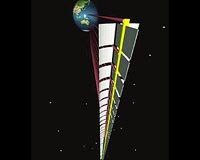 |
Bonn, Germany (SPX) Nov 11, 2009 At the German Aerospace Center facility in Lampoldshausen, a new solar water-cleaning system (Solare Wasserreinigungsanlage Lampoldshausen; SOWARLA) is using sunlight to remove organic and inorganic contamination, which is rather difficult to break down, from waste water. The heart of the system is a new type of solar receiver that obtains the energy required for the removal of a variety of pollutants from solar radiation. This new system, based on DLR expertise, has been launched under the name 'RayWOx'. The Sun's rays, combined with photocatalysts, can be used to destroy pollutants dissolved in water. Many pollutants are removed from the water by this photochemical cleaning process, very efficiently and, using sunlight as the energy source, also in a very environmentally-friendly and resource-efficient way. The exceptional effectiveness of the process has been proven for many types of very problematic waste water. Pharmaceutical agents such as antibiotics, X-ray contrast media and hormones have been destroyed in waste water as securely as chlorinated hydrocarbons from polluted groundwater, harmful substances in exhaust-air scrubbing solutions from textile manufacturing or toxic materials in municipal waste water. The technique of photocatalytic water cleaning thus offers an outstanding method of cleaning for a wide field of critical waste waters, using a large number of environmentally-friendly processes. The solar researchers at the DLR Institute of Technical Thermodynamics contributed their skills in the field of photochemistry and solar technology and, in collaboration with Hirschmann Laborger�te GmbH from Eberstadt and KACO new energy GmbH from Neckarsulm, developed an industrially useful and reliable design for the waste water cleaning system. The systems will be sold by KACO new energy under the 'RayWOx' product name. The demonstration system operating in Lampoldshausen is able to completely clean the cooling water from the engine test facilities at the DLR Institute of Space Propulsion, which are contaminated with rocket fuels and their combustion products. The heart of the technology is a solar receiver made of transparent glass pipes. The waste water, mixed with iron ions as acting as a photocatalyst and small quantities of hydrogen peroxide, is pumped through these glass pipes until the absorbed solar radiation has achieved the desired degree of cleaning. In contrast to more familiar solar reactor concepts, the modular 'RayWOx' technology is very easy to install and well-suited for building systems of any desired size in varying conditions. Given suitable weather conditions, the device in Lampoldshausen, with a solar reactor of 49 metres in length and 470 centimetres in width, can clean about 4,500 litres of industrial waste water of all oxidisable contamination in one to two hours. The DLR scientists and the industrial partners involved in this development received the Energy Globe Award 2007 for their cooperative project. The work was part-funded in a project of the German Environment Foundation (Deutsche Bundesstiftung Umwelt; DBU) and supported by DLR Technology Marketing and the Lampoldshausen Technology Transfer Centre. Share This Article With Planet Earth
Related Links German Aerospace Center (DLR) All About Solar Energy at SolarDaily.com
 Japan eyes solar station in space as new energy source
Japan eyes solar station in space as new energy sourceTokyo (AFP) Nov 8, 2009 It may sound like a sci-fi vision, but Japan's space agency is dead serious: by 2030 it wants to collect solar power in space and zap it down to Earth, using laser beams or microwaves. The government has just picked a group of companies and a team of researchers tasked with turning the ambitious, multi-billion-dollar dream of unlimited clean energy into reality in coming decades. With fe ... read more |
|
| The content herein, unless otherwise known to be public domain, are Copyright 1995-2009 - SpaceDaily. AFP and UPI Wire Stories are copyright Agence France-Presse and United Press International. ESA Portal Reports are copyright European Space Agency. All NASA sourced material is public domain. Additional copyrights may apply in whole or part to other bona fide parties. Advertising does not imply endorsement,agreement or approval of any opinions, statements or information provided by SpaceDaily on any Web page published or hosted by SpaceDaily. Privacy Statement |